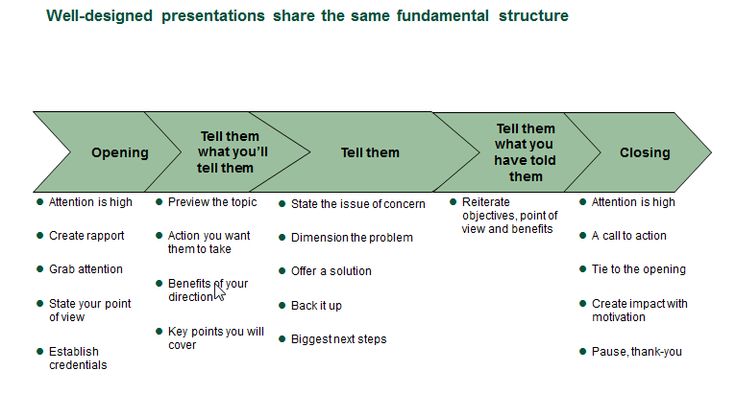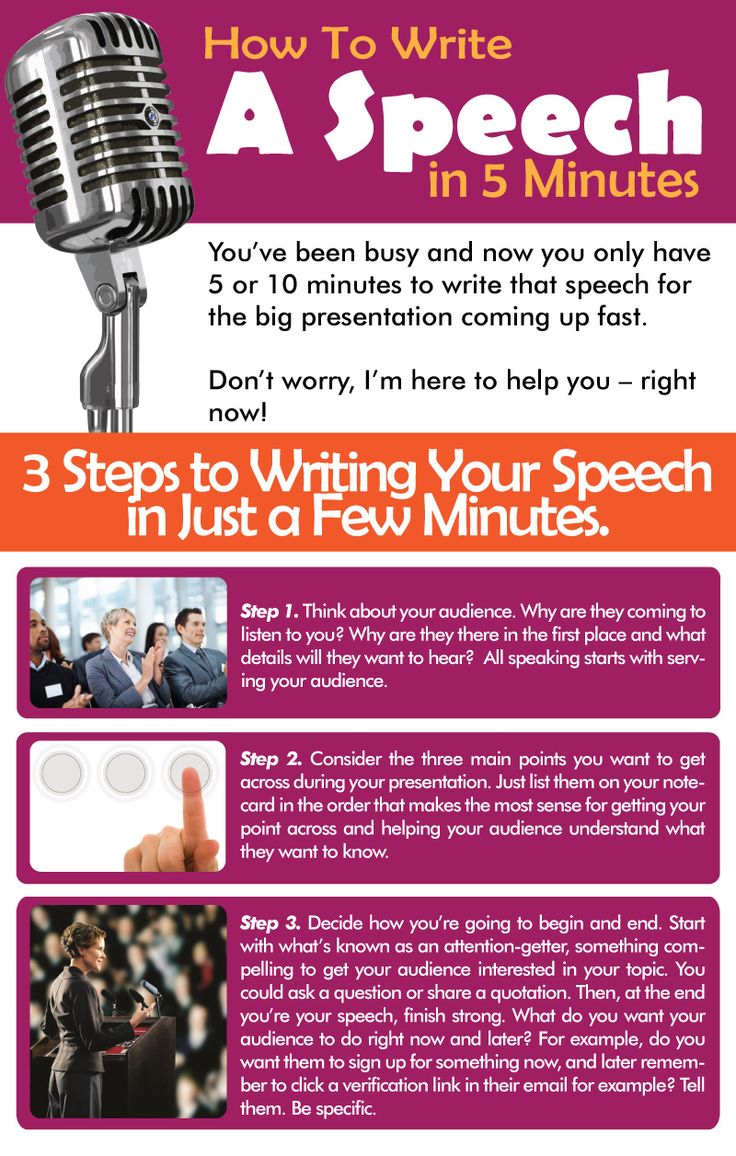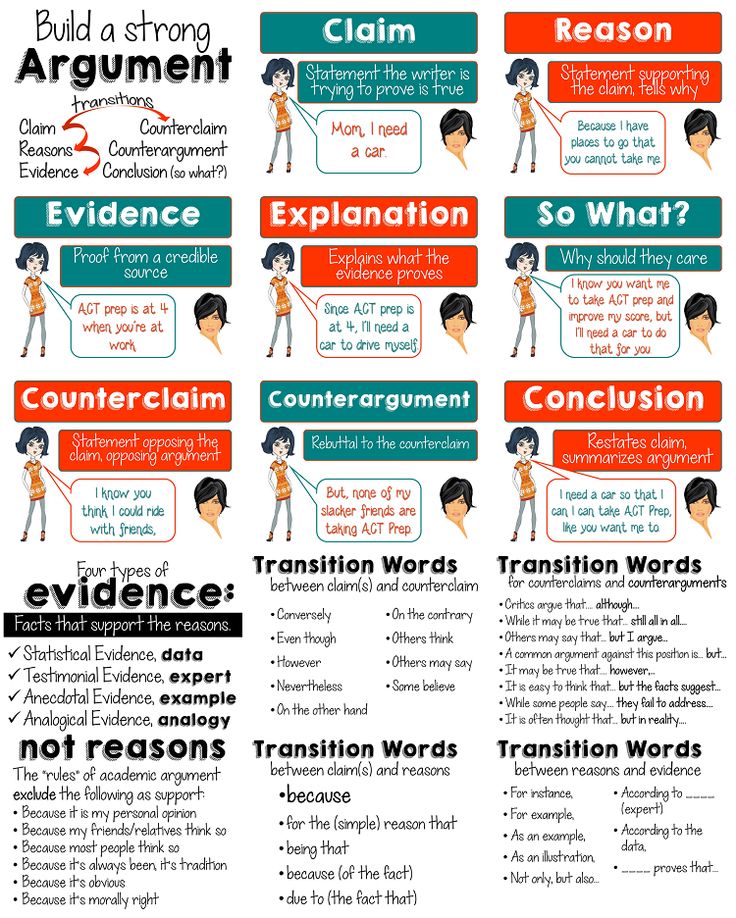Contrary to a popular belief, speech writing isn’t difficult. Speeches are just too different from more conventional types of texts – unlike essays, theses, dissertations and suchlike, speeches combine the elements of both written and spoken word; and it is exactly what baffles even those who are good with words. This guide will help you get things sorted out and lead you through the process of writing your first speech.
Basic Speech Structure
As a speech is aimed to be perceived by ear, it is only natural that structurally it should be quite simple, so that audience doesn’t get confused and distracted. In most cases, it consists of three parts:
- Introduction – it catches the audience’s attention and prepares the groundwork;
- Body – the ‘meat’ of your speech, it contains the majority of information you are about to share;
- Ending – here you sum up what you’ve already said and draw conclusions.

Source: https://i.pinimg.com/736x/59/4d/e7/594de761da031e5a2980da95835e6bb2.jpg
As with many other types of writing, when working on a speech it is advisable to put off writing an introduction until the very end – we will touch upon why later. And now, let’s work on the content.
Considering the Audience
Taking the audience into account is important for any kind of writing; but it goes double for speeches. An essay, theoretically, can be read by anybody, whether you intend it or not. A speech, however, is read for particular people in a particular situation, and you usually have a much better understanding of who are you going to speak for, what they may be interested in and which points are likely to impress them most.

Source: https://i.pinimg.com/736x/de/c8/51/dec851c1ecd2c5ea874b4fa1a923a9bc.jpg
That is why you have to write the speech not from your own, but from your audience’s point of view. Try to imagine an average member of this audience, a person most likely to listen to you. There may be and will be deviations, but usually you have a fairly good idea of what the majority of your listeners are like.
Now ask yourself these questions:
- Why did they come to listen to you?
- What do they expect to hear?
- What information do they want to learn?
- How can you present the information to best serve your audience’s needs?
- What type and style of language will be best suited both for the audience and the topic?
There are no surefire methods and approaches in this area – every audience is unique, and your approach should be unique as well. Follow your common sense, and try to imagine yourself in the position of a listener – it may help.
Writing an Outline
Depending on how much time you are going to have, the number of points to cover may differ, but it is a good rule of a thumb to draw a line at three – it is better to keep your speech short anyway. However, this rule is not set in stone – if you have to deal with a number of small ideas, there may be more than three of them. Just make sure they follow each other in a logical manner and don’t jump at the listeners from nowhere.
Source: https://www.youtube.com/watch?v=M4BkVmA0p6Y
Your outline will include the following:
- Points to cover in the body of the speech, each with a couple of sentences of deliberation;
- How much time you are going to speak about each particular point;
- How you are going to link individual ideas to create a coherent whole;
- Possible ideas on introduction and ending (you may end up not using them).
How to Write the Body of a Speech
First of all, remember that you are not writing an essay. You are going to actually say everything you write, so make sure it is closer to oral speech than your usual writing. It doesn’t mean that it should be completely like normal oral speech, with all its repetitions and stuttering. But it does mean that sentences, on average, should be shorter, the language crisp and clean, sentence structure simple – otherwise you will be hard to follow. Nevertheless, make sure to build up strong argument:

Source: https://i.pinimg.com/736x/ac/48/6c/ac486c4e1ab5273177cf9875bcc1f620.jpg
As for the rest, it is hard to give a plan that would help you write a top-notch speech in all situations, but there are a number of guidelines following which can greatly increase your chances for success:
- Say everything you write out loud. If it doesn’t sound right (too obtuse, too verbose or incoherent), try to word what you mean to say differently or drop it altogether;
- Use a stopwatch to mark how long it takes you to read each paragraph (which should roughly equal one point to cover). It is especially important if you have a time limit – it will be easier to cut certain parts down in size if necessary;
- It may be a good idea not to write down everything you are going to say. That is, you may write it down when you first prepare your speech to fix all the points and ideas in your mind, but later, when you are getting ready to give the speech proper, it may be better to just jot down the basic ideas and transition points. This way you will be less dependent on particular word combinations and more flexible – if you forget what exactly you were going to say, it will be easier to formulate the ideas in a different manner than if you tried to memorize the speech;
- Make sure to pay special attention to transitions or links and don’t rely on yourself to think about something on the spot. Nothing is more jarring than a speaker who forgets why one point is supposed to lead to another and simply changes the topic halfway through.
Revising the Body of the Speech
Speech, by definition, is a fairly short piece of text – even if you don’t have a rigid time limit, it is always better to be curt than long-winded. You may think that you have so much to say, so much to impart with your audience, but it is all different from the position of a listener. Just remember how you yourself usually feel when listening to someone giving a speech – nine times out of ten, after a couple of minutes listening to somebody it becomes painfully obvious that this person on stage is eating up the precious moments of your life, and the longer he keeps talking the more annoyed you grow.
This is what you should remember first and foremost when revising your speech – and be ready to spend most of the time you work on it on this stage.
- Check your tone. Does it take audience, occasion and topic into consideration? Is it consistent throughout the speech?
- How long are your sentences? Remember, it is oral speech, and your listeners won’t have the luxury of going up a couple of lines to see what a sentence started with. Speeches with generally long sentences sound boring and sluggish – and you don’t want that;
- Do you use words everybody in your audience will understand? Do you yourself understand them? Again, shorter is better – a one-syllable word is better, quicker and more energetic than its 5-syllable synonym. Longer words may sound impressive to you, but when spoken from stage they create an impression of pomposity and cleverness for cleverness’s sake;
- Don’t be afraid of repetitions. Unlike in written texts, in speeches they are not only tolerable but very useful. You are dealing with a number of living people, most of whom are likely to be easily distracted. Even during the best speeches delivered by the famous speakers people tend to drift off from time to time – and if they are suddenly brought back from this reverie to discover they don’t have an idea of what the speaker is going on about, it may be a good idea to hammer the key ideas, words and images home every now and then. This way the gist of the speech will remain with them even if they spent most of it lost in thought.
Writing an Ending
Ideally, your ending should be a highly memorable and rousing call for action. You have been leading up to it for the entire duration of your speech, building up pressure – and now is the time to deliver a final blow.
Source: https://www.youtube.com/watch?v=NyE1Kz0e–0
It may be a good idea to think what the main idea of your speech is, what you want your listeners to bring home with them after listening to it. Boil it down to a short, snappy epigram 15-20 words long and place it near the end, where it is likely to attract the most attention.
In order to decide what kind of call to action to choose, you should return to the very beginning and ask yourself: what was the primary purpose of giving this speech? To persuade the listeners? To impart information? To motivate them? In other words, you should ask yourself what you want the listeners to do as a result of listening to you – and call them to do so.
Among other powerful ways of ending a speech are:
- Primarily used when you have to motivate the listeners;
- If you know a quote that covers the topic you’ve discussed and is sure to give your listeners some food for thought, go for it – thus you will not only end the speech on a powerful note, but call for the authority of a well-known person;
- Call back. Remember some event in the past you are sure all your listeners are familiar with.
Always plan how you end the speech in advance – together with the opening it is probably the only part of the speech worth memorizing. Here are some common mistakes resulting from the lack of planning:
- Sudden ending – the ending jumps out of nowhere, without transitioning from the body of the speech;
- No ending – you suddenly realize there is no underlying thought to consolidate your ideas and mutter a helpless “That’s all I was going to say”;
- Prolonged ending – instead of being short and snappy, your ending draws on and on, turning into yet another body paragraph;
- Poor timing – if you are given a time limit, failing to time the speech and its different parts may lead to running out of time before reaching the ending. Shorter than necessary is acceptable, longer – hardly so;
- Sudden appearance of new information – ending is a place for conclusion, not for additional data. If you suddenly remembered something crucial when you are in the middle of ending, it is better to do without mentioning it rather than confusing your listeners.
Writing an Introduction
You ought to have the entire speech poised and ready before getting to this part, because introduction is by far the most important segment of any speech, and by the time you reach it you should have a good idea of what your speech is about.
Source: https://www.youtube.com/watch?v=XAaSZ64P8pA
Introduction is the part that defines whether the rest of the speech is going to be listened to – if you fail to catch the attention of your audience with the first couple of sentences, you may not bother going through the motions of delivering the rest.
What you catch their attention with are called “hooks” – introductory parts that exist for the sole purpose of attracting attention and making the audience feel interested in listening to the rest. The most common types of hooks are as follows:
- Shocking or outrageous statement – say something that will make the audience wonder if they’ve heard you right;
- Humorous story related to your primary idea – humor is one of the best ways to attract attention, just make sure what you are saying is really funny so as not to make your audience cringe;
- Question – make the listeners engage with you from the very first second.
Source: https://www.youtube.com/watch?v=w82a1FT5o88
And keep it short – which is true for the speech in general. Don’t overestimate your ability to interest people. Human attention span is short, and every minute you spend speaking costs you the attention of a few – or many, depending on how boring you are – audience members. It is better to cover 3 most important points in seven minutes and end snappily than to drone for half an hour, making the audience want to gag you.